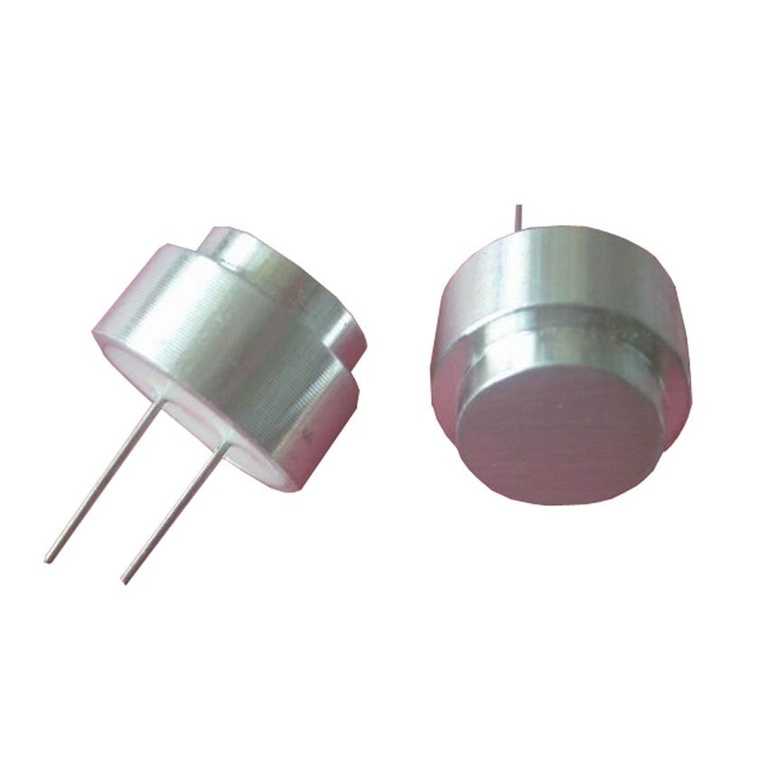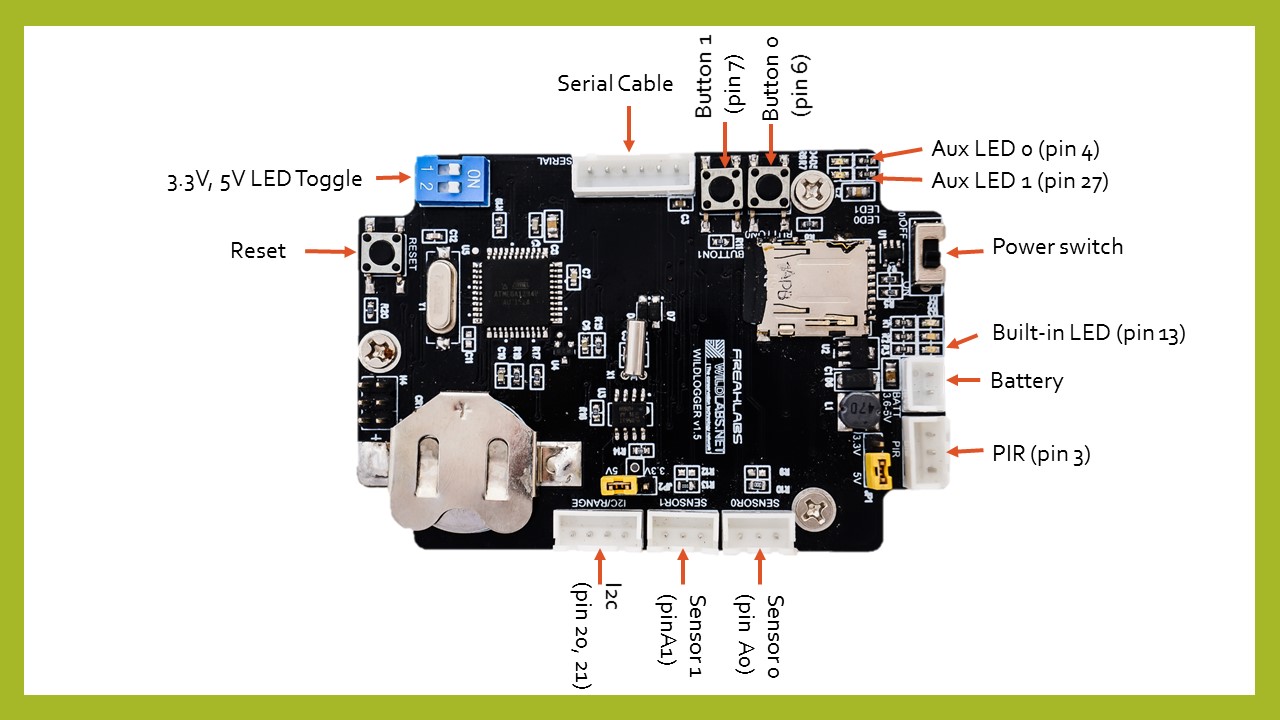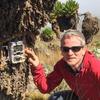Ready to put your Tech Tutors skills into practice? WILDLABS and Freaklabs are proud to announce our new virtual course: Build Your Own Data Logger. This eight-part video tutorial series will guide wildlife and conservation researchers through building and deploying custom hardware using the Arduino platform. To join, Register now!
This course is free to all, but if you would like to build along with the course in real-time, you can purchase the WildLogger board and kit for $30 (USD) here
About the Series
If our first season of Tech Tutors inspired you to put your conservation tech skills to the test, we've got a brand-new experience coming to WILDLABS! Where can you start learning how to use Arduino to build custom devices for wildlife and conservation research? Right here!
Beginning this November, WILDLABS and Freaklabs are proud to introduce an eight-part video tutorial series that guides wildlife and conservation researchers through building and deploying custom hardware using the Arduino platform. The series will use WildLogger - an Arduino-based board that’s designed for deployment - to create a custom data logger.
Are you new to Arduino, or maybe not entirely sure what Arduino is? Good news - this series is for beginners like you! By the end of our eight modules, you'll have the practical skills and knowledge base you need to deploy your creation for real.
The series assumes no hardware experience. It’ll cover common terminology, components, the hardware design stack, setting up the Arduino environment, programming and optimising your application, choosing and modifying enclosures, piloting, testing, deploying and troubleshooting.
You’re not on your own. Our interactive series makes it easier than ever to get feedback and guidance as you learn. Every two weeks, we’ll host a live Office Hours event to troubleshoot, answer questions in person, and release the next module in the series. We'll also have cheat sheets and code to download, plus a forum to ask questions between sessions. And of course, you can build along with the course in real-time with the WildLogger board and kit, available here.
The tutorial is free and allows you to move at your own pace with videos available to all on the WILDLABS Youtube channel. To navigate through all course content, visit the Course Directory.
To join this virtual course, register here!
Group curators
- @Freaklabs
- | He/Him
Freaklabs
I'm an engineer and product designer working in conservation technology. I specialize in technology for landscape restoration and wildlife behavioral ecology.



- 1 Resources
- 307 Discussions
- 20 Groups
Freaklabs
Develops open source technology for wildlife and conservation researchers



- 0 Resources
- 11 Discussions
- 2 Groups
No showcases have been added to this group yet.
- 0 Resources
- 0 Discussions
- 22 Groups
Centre national de la recherche scientifique (CNRS)
Behavioural ecologist @CNRS in France - working on large mammals in Europe and Africa



- 0 Resources
- 10 Discussions
- 6 Groups
- @Amanda83
- | She
I love to help out
- 0 Resources
- 1 Discussions
- 11 Groups
- @iruss
- | she/her
Masters student working on hazel dormouse acoustics
- 0 Resources
- 1 Discussions
- 6 Groups
- @srankin
- | she/her
NOAA Fisheries
Bioacoustics researcher with the National Oceanographic and Atmospheric Administration (NOAA).
- 0 Resources
- 2 Discussions
- 16 Groups
Software engineer working on natural resource management technology.
- 0 Resources
- 3 Discussions
- 6 Groups
My research focuses on using Next-Generation Sequencing (NGS) to study endangered species, including carnivores, chiropterans (bats), and lizards, as well as their microbiomes.
- 1 Resources
- 4 Discussions
- 19 Groups


- 0 Resources
- 31 Discussions
- 4 Groups
Wildlife researcher

- 1 Resources
- 13 Discussions
- 4 Groups
Scaling biodiversity monitoring, using smart sensors and ai-pipelines

- 0 Resources
- 2 Discussions
- 10 Groups
- 0 Resources
- 5 Discussions
- 1 Groups
- @StephODonnell
- | She / Her



- 196 Resources
- 676 Discussions
- 31 Groups
The Marine Innovation Lab for Leading-edge Oceanography develops hardware and software to expand the ocean observing network and for the sustainable management of natural resources. For Fall 2025, we are actively...
6 October 2024
Can conservation-based incentives promote the willingness of local communities to coexist with wildlife? A case of Burunge Wildlife Management Area, Northern Tanzania
10 July 2024
Manufacturing Partnership Brings Low-Cost Pipistrelle Family of Detectors to Researchers, Ecologists and Bat Enthusiasts Around the World
2 July 2024
WildLabs will soon launch a 'Funding and Finance' group. What would be your wish list for such a group? Would you be interested in co-managing or otherwise helping out?
5 June 2024
Article
Read in detail about how to use The Inventory, our new living directory of conservation technology tools, organisations, and R&D projects.
1 May 2024
Article
The Inventory is your one-stop shop for conservation technology tools, organisations, and R&D projects. Start contributing to it now!
1 May 2024
The primary focus of the research is to explore how red deer movements, space use, habitat selection and foraging behaviour change during the wolf recolonization process.
10 February 2024
A secure platform designed for those working to monitor & protect natural resources. Insight facilitates sharing experience, knowledge & tools to increase efficiency & effectiveness in conservation. By...
7 November 2023
Can you create an ecological data collection application on Android for Gibbon and Biodiversity Research. Check out this opportunity with us!
24 August 2023
We are recruiting a graduate student to work on a 3D groundwater flow sensor in collaboration with USGS. Experience with C/C++ or similar programming languages is preferred, but not required.
12 July 2023
Spaceborne Satellite-tag RF Systems to Measure Spatiotemporal Patterns of Wildlife
12 July 2023
Careers
Permanent and Full Time role at the UK Centre for Ecology & Hydrology
8 June 2023
November 2023
event
| Description | Activity | Replies | Groups | Updated |
|---|---|---|---|---|
| An observation I made when first experimenting with DHT22 modules with a Raspberry Pi years ago that still seems true with Arduino and DHT11 sensors. The first reading of... |
|
Build Your Own Data Logger Community | 4 years 6 months ago | |
| @Jeffm Oh that's great to hear. We've had a couple of cable issues so far, but I'm really glad you got the problem sorted. Onward and upward! Akiba... |
+18
|
Build Your Own Data Logger Community | 4 years 7 months ago | |
| Ha ha ha. it will be much more important than that later on. Stay tuned :) Akiba |
|
Build Your Own Data Logger Community | 4 years 7 months ago | |
| Hi Liam. To get the cables through the cable gland, we'll need to remove the wires from the terminal housing and then reinstall them. That will be in a later module... |
|
Build Your Own Data Logger Community | 4 years 7 months ago | |
| Thank you, that's very helpful. Nice to see it is a shortcut. |
|
Build Your Own Data Logger Community | 4 years 7 months ago | |
| Hi everyone, while beeing separated from my Wildlogger board I still had to play with some sensors ;-) Ceck out this wonderful project: https://sensebox.de/en/ Great to learn... |
+2
|
Build Your Own Data Logger Community | 4 years 7 months ago | |
| Hi there! Yes, we're in the process of working out the new schedule - several of the modules have ended up being longer and more in-depth than we originally expected, so we... |
|
Build Your Own Data Logger Community | 4 years 7 months ago | |
| Oh! Okay that's good to know, we'll move the links. |
|
Build Your Own Data Logger Community | 4 years 7 months ago | |
| Ah yes! Rookie mistake and soon as I saw your response I remembered the #include #define needed to be outside the setup. Thank you! |
|
Build Your Own Data Logger Community | 4 years 7 months ago | |
| It would slot in to replace the usual SD storage card, with power, controls and antenna etc. hanging off thin wires -- the idea being to fit as many existing products as possible... |
+5
|
Build Your Own Data Logger Community | 4 years 7 months ago | |
| Hi. I guess we haven't made it prominent enough. Here is the github link where you can find all the code for the virtual course: Link Hope that helps :) Akiba |
|
Build Your Own Data Logger Community | 4 years 7 months ago | |
| @vickiedenicola In your code to set the baud rate you write: cmd.begin(57600); Have you tried this with: Serial.begin(57600); |
+12
|
Build Your Own Data Logger Community | 4 years 7 months ago |
Code location online?
16 December 2020 6:33pm
Module 3.1: Programming Basic Functionality
7 December 2020 10:38pm
14 December 2020 4:56pm
When you get a chance, can you please upload PDF's of the slides for the 3.2 videos? Thanks!
14 December 2020 6:07pm
Hi Akiba,
The problem was in the carriage return !
If this option is not activated, the commands entered in the serial port do not produce the correct sequence
Now it's fine !
Thank you !!
15 December 2020 2:12pm
@vickiedenicola
In your code to set the baud rate you write: cmd.begin(57600);
Have you tried this with: Serial.begin(57600);
Western Hemisphere Office Hours Today!
15 December 2020 1:10pm
Microphone and ePTFE
11 November 2020 6:58am
16 November 2020 4:41pm
Would ultrasonic trransducers also work as ultrasound microphones? If so, there are waterproof ultrasonic transducers that exist. It's possible to encase these either in silicone rubber, epoxy, or stuff into a cable gland to have a waterproof ultrasonic microphone. I've attached a pic of one for reference.
Akiba

8 December 2020 9:16pm
Hi Cryssy,
I am also looking for membranes to waterproof mics used for recording bat ultrasound. The people at Open Acoustics Devices is using Porelle® AV5ID acoustic membranes for the AudioMoth moulded case (https://github.com/OpenAcousticDevices/Application-Notes/blob/master/An_Injection_Moulded_Case_for_AudioMoth.pdf). I wonder if someone in the WildLabs Community may know how to get them in small quantities. I have only found dealers that sell them in large quantities (+2000), I guess for the cell phone market (for example, https://selectronix.co.uk/collections/waterproof-acoustic-vents/products/black-acoustic-vent-11x5mm-ip68-3m-30min).
Let me know if you find something,
Best wishes, Toni
9 December 2020 2:04am
Hi Toni.
We have some ePTFE samples that we're testing for the webshop. If you're interested in characterizing ePTFE samples for high frequency audio, we can send some out to you.
Akiba
North/Central/South America (western hemisphere) viewing party?
13 November 2020 3:13pm
1 December 2020 12:07pm
Hi. Just an FYI. I asked Carly if we were meeting weekly and she said it was going to be bi-weekly. So as far as I know, there's no watch party tomorrow. Is this correct? If so, then I think the registration needs to be updated since it filled my calendar with weekly events instead of bi-weekly events.
Thanks.
Akiba
2 December 2020 1:03am
Hi Akiba,
Yeah that's right, it's bi-weekly, so next Tuesday will be the next event! I'll see if Carly can change the registration details so it'll show the new schedule.
7 December 2020 5:15pm
Hi all!
So the next Western Hemisphere office hours will be NEXT Tuesday (Dec 15) at 5pm EST/2pm PST. Since the module videos and info are released today and every other week from today, we wanted to give folks a chance to work through stuff on their own a bit and then come prepared with questions/problems for the office hours. For those who've already registered through the Zoom link, I just re-sent the confirmation email with the updated dates. To anyone who wants to join in, register here!
-Carly
BYO Data Logger: Introduce Yourself!
6 November 2020 8:20pm
2 December 2020 9:07am
Hi Greg.
Wow, I'm glad the boards got to you. Jacinta and I are still working on the modules and I'm discovering creating video takes much longer than I had anticipated. Jacinta's more pro. For the course, we're targeting people that are completely new to Arduino and are deliberately pacing it so that it doesn't overwhelm everyone. But if you have more experience and want to move forward on your own, here's some info and things you can do.
We're running behind on documentation because all our time is taken creating video, assembling kits, and shipping out orders. But I've attached an image that should help out in understanding the pin mappings.
I also recommend you test out the realtime clock and SdFat library on your board. You can download them from the Arduino library manager. Search for Rtc_PCF8563 and also the SdFat library in there. Also, the SdFat uses pin10 for the chip select.
If you run into problems, we'll be dropping the videos for the command line, temperature/humidity sensor, and analog digital converter next Tuesday. Two weeks after, we'll be dropping the videos for realtime clock, SD card, and interrupts.
You might also be interested in the video where we do the toplevel integration for the app and also the power and reliability optimizations. Those come in January.
Good luck and if you get stuck, feel free to ask questions and the course videos will be rolling out soon :)
Akiba
p.s. Once we have everyone on the same page with the fundamentals, then we have some ideas on really interesting follow-on courses/projects that build on that :)

2 December 2020 10:53am
Akiba,
It's great to have an Arduino that integrates most of the things that we need on the board. Previous projects have required a spaghetti of all-too-fragile interconnects. The design seems quite well thought out.
I'll do as you suggest with the realtime clock and SdFat libraries. Sharing the sketches on your GiHub repository https://github.com/freaklabs/byo-datalogger/tree/main/WildLogger would be very helpful.
Kind regards
Greg
2 December 2020 12:28pm
Hi Greg.
I'm glad you like the WildLogger. It's actually a variant of a design we use all the time. Jacinta and I come from a background in environmental monitoring and international development. The types of designs and the problems are very similar to wildlife conservation and research. We'd be floundering if we had to design consumer electronic devices. Ha ha ha.
We'll be uploading code to github for the modules as we release the videos. If you want to work ahead and you have questions though, feel free to post here or in this forum.
Akiba
Module 1: Understand the Design Stack
9 November 2020 10:02pm
18 November 2020 11:13pm
Thanks David,
Glad you're finding it useful :)
Also, just to add, yup WildLogger is open source, so feel free to take and adapt :)
cheers
Jacinta
27 November 2020 4:17pm
FYI ordered the 11th, send the 13th, arrived in good order today, the 27th, in the UK .
28 November 2020 12:24am
Hi Egil.
Thanks for the info. It looks like UK deliveries are pretty consistent at around 15 days on average +/- a few days.
We are seeing much more variability for the US which is fast for some and slow for others. If anyone has any questions or wondering about their order, feel free to email us or PM us on Wildlabs.
Akiba
Memory & Power - Alternatives
11 November 2020 10:37am
27 November 2020 12:40pm
Hi Rob.
Congratulations on getting it to work!!
Yes, most batteries come with the JST-PH connector which has a 2mm pin spacing. If you have the equipment and components to crimp on a JST-XH connector which has a 2.54 mm spacing, that would fit into the Wildlogger board. As a warning, the virtual courses and the Freaklabs designs will standardize on the JST-XH connectors with 2.54 spacing because they're compatible with standard electronics prototyping gear like breadboards, and standard 2.54mm (0.100") header connectors. However the JST-XH connectors have polarity (they can only be plugged in one way) and lock (they require additional force to remove) which is why we are using them.
Anyways so if you can crimp on JST-XH connectors, I recommend doing it for your Li-Po (Lithium-Ion-Polymer) battery. For single cell Li-Po batteries, they are compatible with WildLogger and can replace the stock battery case. We used the standard case because we were worried about what kind of batteries were commonly available throughout the world. Alkaline AA batteries are easily found everywhere so we decided to go with those for this first course. That may change in the future or that we offer different battery options for future courses and designs.
Hope that helps.
Also for those that are wondering what JST-XH and JST-PH are, JST is a company that makes a type of connector that is commonly used for cable harnesses. In general, they are commonly used fo batteries, but also for other types of cables. JST-XH is a specific polarized locking cable connector with a 2.54 mm (0.100") pin pitch. JST-PH is a specific polarized locking cable connector with a 2.00mm pin pitch. In general, I prefer polarized, locking connectors because it's not possible to plug them in backwards and because they lock, it's hard to inadvertently pull them out or for them to fall out due to vibration. The standard connectors you might recognize are Molex 2.54 mm connectors which don't have polarity and locking so it's possible to plug in cables backwards and have them fall out. They're okay for general usage, but when possible we use JST-XH. I've attached a pic of Molex 2.54mm connectors and JST-XH 2.54mm connectors below for reference.
Also we will be covering crimping our own cable harnesses later. It's an important skill and cable harnesses are one of those unglamorous things that are critical for devices and deployment but aren't really talked about much.
Akiba


27 November 2020 3:11pm
Hi Akiba,
Thanks for that. I've not added hardware to the Arduino IDE before, so that was useful to learn. I've just got an original Commodore 64, to have a nostalgic retro Christmas, to re-learn BASIC and hopefully learn some machine code & the principles of computer architecture. Hopefully when I turn it on, the smoke will stay on the inside! : )
Yes, it was the male connector on the battery I was thinking of changing (not the female connector on the board). I'm not going to, it was just to check it was OK to do so; if the need ever arose; for future reference. Interesting, I was thinking about the issue of the connectors locking/ pulling out, and their accessibility in the case.
I'd be interested to learn more, as you say in the future about different battery options.
Cheers!
28 November 2020 12:16am
Hi Rob.
The battery connector would be the easiest connector to change from PH to XH. Also the Wildlogger board can tolerate any battery input between 3.6V and 5V. We purposely chose this range so there is compatibility with single cell lithium-ion and lithium-ion-polymer batteries as well which are 4.2V nominally.
Yes, batteries are fascinating and one of the biggest issues we deal with for these types of applications. They're often the limiting factor for drones, tracking collars, and long term monitoring devices. They also don't scale with technology so no matter how tech improves, we still essentially deal with decades old battery technology. Ha ha ha.
Hopefully that seems like it might be changing :)
akiba
Module 2: Setting up the Arduino IDE
24 November 2020 12:00am
Office Hours: Module 1
20 November 2020 12:21pm
20 November 2020 2:34pm
Hi everyone.
For this week's office hours, we'll be giving a preview of Module 2 which will be released after office hours and answering questions about Module 1. We'll also be answering any other questions you might have regarding hardware, sensors, datalogging, etc. Looking forward to chatting on Tuesday.
Also we'll be discussing with @carlybatist to arrange that Jacinta and I will be available for the western hemisphere (Americas and Africa) meetup as well. We didn't expect so much geographically diverse interest in the course. Ha ha ha.
Akiba
Module 1: Understand the Design Stack
10 November 2020 12:00am
Build Your Own Data Logger Virtual Course
19 October 2020 12:00am









































16 December 2020 11:02pm
Hi. I guess we haven't made it prominent enough. Here is the github link where you can find all the code for the virtual course:
Link
Hope that helps :)
Akiba